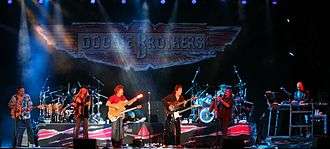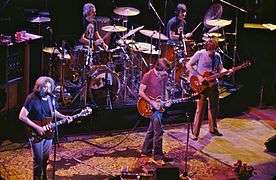Double drumming
Double drumming (sometimes referred to as double drums) is a musical technique, used mostly in rock music, where two drummers each play a drum kit at the same time. One may play the rhythm while the other may play another style, or both may play the same rhythm. It is more common to have a main drummer with an auxiliary percussionist who plays Latin American percussion, toms, or mallet percussion, but this is not considered "double drumming".
Featuring two drummers has been common in jazz music, in particular in free jazz.[1]
List of bands including double drumming/additional percussionists
_at_Quart_Festival_2005%2C_Norway.jpg)
...And You Will Know Us by the Trail of Dead performing in 2005

The Doobie Brothers in concert on August 31, 2006

Genesis performing in 2007

The Grateful Dead in 1980
- 38 Special (two drummers:1974-87)
- ...And You Will Know Us by the Trail of Dead
- ABBA (two drummers during their 1977 Australian Tour)
- Adam and the Ants 1980–1982.
(Also for Adam Ant solo live shows 1982–1984, 1995, 2010, 2011–present) - Add N to (X)
- The Allman Brothers Band (two drummers 1968–82 and 1989-91; two drummers and percussionist from 1991–2014)
- Angels of Light
- Apollo 440 (Stop the Rock)
- Arcade Fire
- The Arcs
- The Band (occasionally after 1983 reformation)
- Big Pig
- Black Eyes
- Bleachers[2]
- Bloc Party
- Blues Image (1966–1970)
- Bon Iver
- Brand New, 2014 tour
- Bright Eyes
- James Brown (intermittently, especially ca. 1966–76)
- Butthole Surfers, 1983–1985, 1986–1989, 2009
- Clear Light
- Phil Collins (Chester Thompson, touring)
- John Coltrane, on Meditations (1966)
- Combichrist (additional percussionist)
- Concussion Ensemble (three regular drumkits, plus junk percussion)
- Course of Empire
- Crash Worship
- Cult of Luna
- Dananananaykroyd
- Danielson
- Demetrius Williams and Malachi Burgess, double drummers for DPB Band and with Brian Haas of JFJO and others
- The Dirtbombs
- Do Make Say Think
- The Doobie Brothers
- Eagles of Death Metal
- The Fall, 1981–1984, 1993–1997 (occasional), 2014–2016
- The Feelies
- Foreigner
- Frank Zappa and The Mothers Of Invention (two drummers:1966-69; drummer and percussionist:on and off from 1973-88; two drummers and percussionist:1973-74)
- Fugazi (early 2000s shortly before breakup)
- Genesis (1976–1993, 2007; Bill Bruford and then Chester Thompson, touring)
- The Glitter Band
- Godsmack (occasionally)
- Godspeed You! Black Emperor
- Gorillaz (2010 Tour)
- The Go! Team
- Grateful Dead (two drummers:1967–1971, 1974–1995 [3])
- Ground Zero (most but not all lineups)
- Hawkwind (1974–1976; occasionally thereafter)
- Hidden Orchestra
- Hollywood Undead (an additional percussionist who plays on a kit that consists of both electronic and acoustic drums)
- Ill Niño (additional Latin percussion, consisting of bongos etc., including regular cymbals and drums)
- Incubus
- Indigo jam unit
- Joe Bonamassa
- Joe Walsh
- Jukin' Bone
- Kamasi Washington
- King Crimson (drummer and percussionist:1972–1973; two drummers:1994–1997 and 2008; 3 drummers since 2013)
- King Gizzard & the Lizard Wizard
- Koinonia (two players, each with drumsets and aux percussion and varied usage) [4]
- Kylesa
- Levon Helm (during the 1980s)
- Little Richard (1997–2013)
- Joe Lovano's Us Five band, ca. 2009–2012
- The Melvins (2006-2015)
- Ministry (during tours 1989–1990)
- Modest Mouse (2004-12)
- The Moody Blues (additional touring drummer:1991-Present)
- Morphine (two drummers:1998-99)
- Motograter (additional. "Smur drums" consisting of steel barrel drums with drum heads)
- Murder, Inc.
- Mushroomhead (main drums + 2 water drumkits [live only], since 2006)
- The National (2019 tour)
- Neoton (acoustic+electronic)
- Needtobreathe
- Nick Cave and the Bad Seeds (since 1994, on most but not all recordings and performances)
- Nomeansno, 1993–1997
- Nothing More (singer Jonny Hawkins performs a solo on a custom kit consisting of a vertical bass drum, a snare drum and a makeshift hi-hat, while the actual drummer repeats simple beats)
- Oomph! (addt. electronic percussion + acoustic backup percussion on live shows)
- Ornette Coleman, first with his album Free Jazz: A Collective Improvisation an early and seminal example of double drumming; and occasionally thereafter[5]
- The Party Boys
- Pavement
- Pink Fairies 1970-1971
- Pink Floyd (1980–1994; touring)
- Poliça
- Queen + Adam Lambert (2017 tour)
- Radiohead (In live performances since 2011)
- Ringo Starr & His All-Starr Band
- Rialto
- Robyn (2007 & 2008 live performances while supporting album, "Robyn")
- Rock Hot Chicks
- Rod Stewart (2017 and 2018 tour)
- The Roots
- Sabaton (only on their Wacken 2019 performance for their 20-year anniversary)
- Showaddywaddy
- Sigue Sigue Sputnik
- Skeleton Key (additional junk percussion, consisting of various pieces of metal items and scrap).
- Slipknot (one drum kit, two percussion setups which include beer kegs)
- Steely Dan (on 1974 tour)
- Swans (on Filth and reunion albums)
- T. Rex (two drummers plus percussionist on Spring 1974 tour,
otherwise one drummer plus percussionist 1971–1974) - Soulwax (three drummers used on From Deewee and 2017 tour)
- Taraf de Haïdouks (a Romanian band)
- Tedeschi Trucks Band
- Thee Oh Sees
- Tortoise (on some but not all recordings and performances)
- Ulver
- Umphrey's McGee
- U.S. Christmas
- The Ventures
- Vinegar Joe
- White Rabbits
- Wizzard
- Yes (during their 1991–1992 Union Tour)
- ZARD (Izumi Sakai)
gollark: ++tel status
gollark: ++tel dial BetsPacksContour
gollark: bees you.
gollark: ++tel dial BetsPacksContour
gollark: It's "Terra's Projects" by the way.
References
- "25 Great Double-Drumming Tracks - Modern Drummer Magazine". Modern Drummer. moderndrummer.com. 20 January 2012. Retrieved 9 November 2017.
- Pareles, Jon (September 5, 2014). "Wallops of Exuberance With Traces of Yearning". NYTimes. Retrieved October 13, 2015.
- Eisen, Benjy (August 1, 2014). "The Grateful Dead's Drummers on Their 'Far-Out' New Collaboration". Esquire. Retrieved October 9, 2015.
- https://i.ytimg.com/vi/Tl5wb2QzK4c/hqdefault.jpg
- DownBeat: January 18, 1962 vol. 29, no. 2
External links
- "25 Great Double-Drumming Tracks", ModernDrummer.com. Accessed December 31, 2014.
This article is issued from Wikipedia. The text is licensed under Creative Commons - Attribution - Sharealike. Additional terms may apply for the media files.